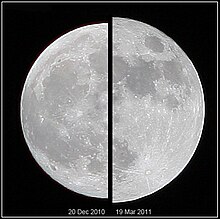
Back Supermaan Afrikaans قمر عملاق Arabic Super Ay Azerbaijani Супэрмесяц BE-X-OLD सुपरमून Bihari သူပါမွန်း BLK সুপারমুন Bengali/Bangla རིམ་འདས་ཟླ་བ། Tibetan Superlluna Catalan مانگی تابان CKB

A supermoon is a full moon or a new moon that nearly coincides with perigee—the closest that the Moon comes to the Earth in its elliptic orbit—resulting in a slightly larger-than-usual apparent size of the lunar disk as viewed from Earth.[1] The technical name is a perigee syzygy (of the Earth–Moon–Sun system) or a full (or new) Moon around perigee.[a] Because the term supermoon is astrological in origin, it has no precise astronomical definition.[2]
The association of the Moon with both oceanic and crustal tides has led to claims that the supermoon phenomenon may be associated with increased risk of events like earthquakes and volcanic eruptions, but no such link has been found.[3]
The opposite phenomenon, an apogee syzygy or a full (or new) Moon around apogee, has been called a micromoon.[4]
- ^ Staff (September 7, 2014). "Revisiting the Moon". New York Times. Retrieved September 8, 2014.
- ^ Plait, Phil. "Kryptonite for the supermoon". Bad Astronomy. Discover. Archived from the original on October 22, 2019. Retrieved August 29, 2015.
- ^ Rice, Rachel. "No Link Between 'Super Moon' and Earthquakes". Discovery News. Archived from the original on June 13, 2011. Retrieved March 20, 2015.
- ^ "What Is a Micromoon?". timeanddate.com. Stavanger, Norway: Time and Date AS. Retrieved August 6, 2018.
Cite error: There are <ref group=lower-alpha> tags or {{efn}} templates on this page, but the references will not show without a {{reflist|group=lower-alpha}} template or {{notelist}} template (see the help page).
© MMXXIII Rich X Search. We shall prevail. All rights reserved. Rich X Search